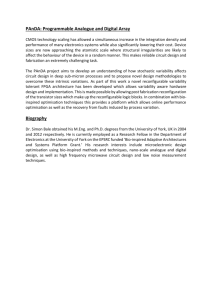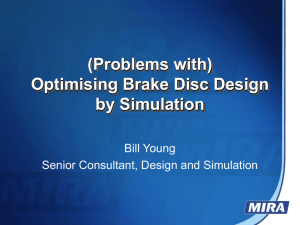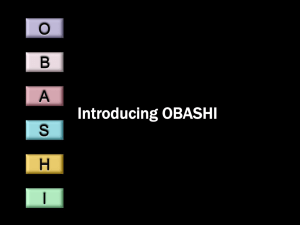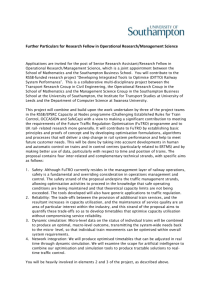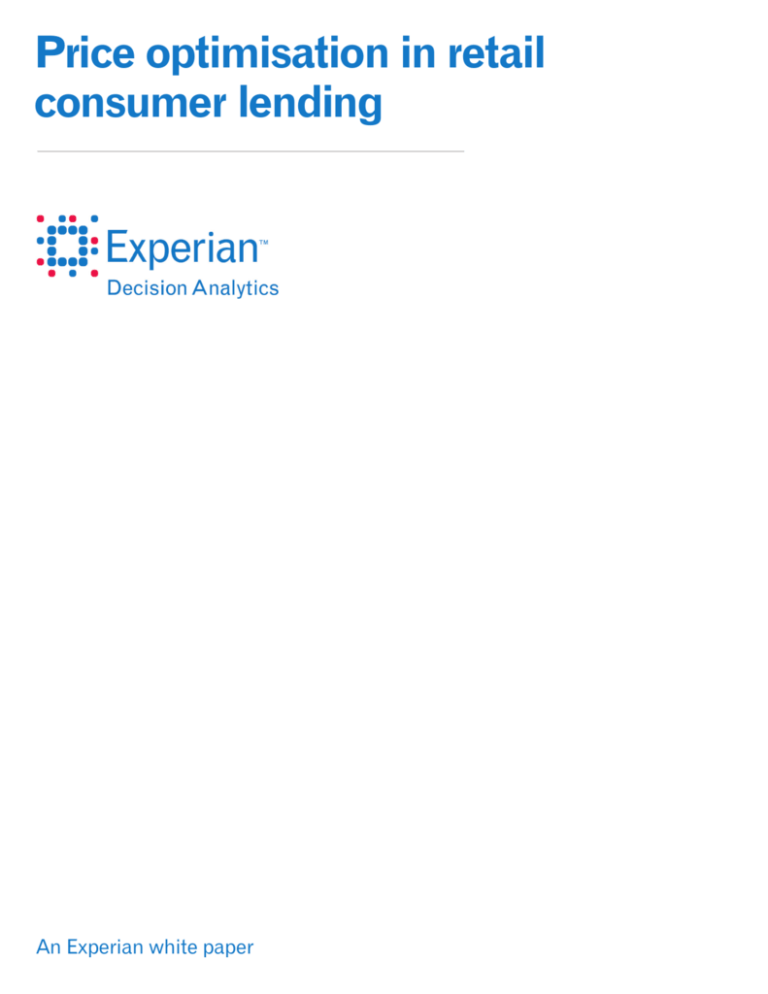
Price optimisation in retail
consumer lending
An Experian white paper
Table of contents
Executive summary......................................................................................................................................2
Background to price optimisation.............................................................................................................4
The implications of constraints................................................................................................................12
How does price optimisation work?........................................................................................................13
Price optimisation in practice..................................................................................................................19
Conclusions.................................................................................................................................................22
Strategy Optimisation solutions from Experian....................................................................................23
About Experian Decision Analytics.........................................................................................................25
An Experian white paper | Page 1
Executive summary
Most organisations now recognise that, while all customers are equal, some
customers are more equal than others. The reality is that different customers
have different profitability and an organisation cannot afford to treat all
customers identically.
If an organisation offered the same price to all customers applying for a loan, then
the same price for each customer would imply an ‘average price’ for every customer.
Low risk customers would secure better rates with other organisations; lower quality
customers would not. As a result, only the relatively higher risk customers will select
the average product, skewing the population down, resulting in increased average
losses and reduced profitability.
The combined effect of ‘average pricing’ is two-fold. Fewer low-risk customers and
more high-risk customers.
Risk-based pricing addresses this issue by offering different prices for customers
with different risk profiles. This works, to a degree, since it equalises margins – but
an increase in price will reduce business volume; the question is, by how much?
Pricing based solely on risk does not address this issue but to maximise profitability
the business needs to understand the price elasticity of customer demand. By
understanding this dimension, the business can start to price each customer to
maximise customer profitability, reflecting the fact that different customers are likely
to take up differently priced loans — something which a simple risk-based approach
usually does not consider.
But is profit always the sole driver in making customer decisions? Of course, in most
organisations, maximising profit is critical; but it is not the only factor. The business
needs to operate within other operational, financial, regulatory and organisational
constraints (such as volume, margin, bad debt) and balancing these different factors
is an essential part of portfolio management. This requires a solution that enables an
organisation to make the best pricing decisions on each customer while maximising
overall profit within business constraints.
Price optimisation not only delivers improved profitability, but also provides the
business with a better understanding of the overall business performance. For many
organisations, the real benefits are gained through improved operational and financial
management and the ability to respond to changing economic and competitive
environments more dynamically.
Page 2 | Price optimisation in retail consumer lending
Specifically, price optimisation enables an organisation to improve its customer
decisioning through:
• Decisioning at a finer level of granularity — decisions can be taken based on the
individual’s specific characteristics not just based on a group of customers within
a segment.
• Taking more factors (or decision dimensions) into consideration when making a
decision—not only risk, but the propensity to take up the loan or lending facility,
early settlement, insurance, value and term.
• Dynamic response to different economic, operational or competitive environments — the ability for price optimisation to evaluate various scenarios and
predict the likely outcome based on each means that changes to decisions can be
evaluated and implemented more quickly.
• Considering factors other than profit as constraints. The business can forecast
profit components and manage profit within these constraints more effectively.
• Making the best possible decision for the customer and organisation by taking
a holistic view of the customer decision. Traditional rule-based decisioning only
considers one customer at a time; price optimisation considers the effect of other
customer decisions in order to work within operational and financial constraints.
• Better management of key business groups. Within a loan portfolio there may be
customers from different sources, for example different dealers, risk segments
or channels. Within auto finance, the management of a third party dealer is often
essential to the business’s performance. Decisions cannot be taken on individual
customers, without considering the wider impact on the dealer relationship.
• Integrating pricing decisions and the operational process. The business recognises
that decisions on new customers cost money. As a result, it should consider the
costs of decisions for different customers in the context of the potential profitability
of that customer.
• The ability to develop strategies that consider different economic outcomes and to
try to ensure that the impact of a potential economic downturn is relatively small.
An Experian white paper | Page 3
Background to price optimisation
Setting the price
There are several ways to set price for any product. The following table from the
Tower Group identifies a number of different approaches that retail banks are
using to set pricing strategies.
Figure 1: Evolution of pricing strategies. Source: Tower Group
Page 4 | Price optimisation in retail consumer lending
Organisations are developing ever more sophisticated approaches that recognise
the need for pricing decisions to distinguish different customer profiles and needs.
The development of advanced analytical techniques has enabled organisations to
increasingly understand customers and therefore differentiate strategies accordingly.
Traditional economic theory teaches that price is set where supply meets demand. If
lenders are able to raise price to increase margins, organisations make supernormal
profits, new suppliers will enter the market, increasing supply and subsequently
reducing price. Conversely, if there is very high competition resulting in reduced
prices and losses some organisations will tend to leave the market resulting in prices
rising back to an equilibrium position.
In reality there are many different markets — customers have different needs, have
different risk profiles and behave in different ways. As a result, there are many
different ‘sub-markets’, each with its own theoretical equilibrium position.
Why differential prices are inevitable for a bank
Most banks offer a range of products and services in order to satisfy the needs
of a wide range of customers: the concept of a ‘universal bank’ is encouraged
by government wishing to ensure that the financially disadvantaged are not
disenfranchised from financial services. Consequently, it is rare for a bank to focus
on a narrow sub-set of customers (although private banks are perhaps exceptions)
and most banks are usually in the business of developing long-term relationships
throughout the customer’s life.
Critical to each business’s success is its ability to identify the specific customer
potential based on better understanding the customer’s behaviour. Over recent years,
the increase in data availability, the ability to process it and the improved decisioning
technology means that there is a natural tendency for organisations to develop
increasingly more sophisticated models to predict different customers’ profit.
But ‘universal banks’ are not the only suppliers in a market. Niche competitors will
specialise in lending to specific customer types. Often through greater availability of
data, more sophisticated analytics, lower service costs and focused marketing, these
organisations will ‘cherry pick’ lower risk customers enabling them to make increased
profit margins. In addition, the longer-term result is that other organisations are
attracted to this market sector, competition increases and organisations then need to
offer reduced rates to gain more or maintain business.
The net effect for an organisation that deploys a single price across different
customer risk profiles is that there are a reduced number of low risk customers in its
portfolio and the average performance of its portfolio declines. In this situation the
organisation has three options:
• Reduce overall prices to restore the profile of its customers — but accept that this
may result in a loss or reduced profit margin
• Increase prices to preserve overall margins — this will shift its market position
down further but will mean that it can maintain unit profits (although at reduced
volumes)
• Introduce differential pricing by customer risk
An Experian white paper | Page 5
The role of risk-based pricing
Risk-based pricing, by definition, allows organisations to vary the price charged
to customers based on the customer’s credit risk.
It allows a business to increase its margins, cover bad debt charges
and potentially lower its cut-offs to accept business that was previously
marginally unprofitable.
Figure 2: By moving from a fixed price to a risk-based price, the business can
increase revenues on marginal customers, enabling it to accept customers of a
higher risk and maintain volumes.
Why risk-based pricing isn’t always sufficient
The limitation with the risk-based pricing approach is that as price increases,
the propensity for customers to take up the loan at a given price decreases.
For higher risk customers, the price increase also results in smaller customer
volumes but the price charged to the customer should be sufficient to cover
the losses.
Conversely, reducing price on lower risk customers means an increased
proportion of customers in this band. This reduces risk profiles, but may also
reduce the average rate (and potentially margin) on the customer base. However,
there are key issues with this overall approach — especially on higher risk
customers which are priced. The problem is that the profile of customers that
take up the loan is likely to be different to the population that does not take the
loan. The result is that increasing the price not only reduces volume but also
increases loss rates to a greater level than that simply predicted by the risk
score. Consequently, increasing prices increases losses and eventually reduces
overall profits.
Page 6 | Price optimisation in retail consumer lending
Profit maximisation for each customer
Assuming we can predict how different customers respond to different prices,
we can maximise the expected profit for each customer. If we maximise profit for
each customer decision then, in theory, an organisation can maximise its overall
profitability by maximising the individual decision for each customer.
The business volume, margins and profit can be plotted against price. As price
increases, volumes decrease and margins increase, but the net impact on overall
profitability is often an initial increase followed by a decline as the volume of
business declines and revenues no longer cover operating and fixed costs.
Different customer groups will have different shaped curves, and so having
differential pricing strategies will deliver different profit results. However, any
organisation has constraints (such as volume, bad debt, market share, proportion
priced) that prevent it from simply maximising profit. This implies that the
business needs to understand the impact of these constraints and determine the
strategy that maximises profit while operating within these constraints.
It is perhaps worthwhile to make a cautionary note at this point. Some
organisations describe the maximisation of profit for each customer as
‘optimisation’. This is true if the business is able to make individual decisions
without impacting the organisation’s overall business goals. However, as
previously identified, maximising profit for each individual customer is not
always possible because of the wider business constraints.
Maximising individual customer profit is a good place to start, but is not the
endgame. The use of the term ‘price optimisation’ should imply the desire to
set price in such a way as to maximise profits within the portfolio through
considering business and operational constraints.
An Experian white paper | Page 7
Price optimisation
To summarise, we have set out the different approaches to making pricing
decisions. Customer pricing ranges from a simple portfolio approach to
an individual price-based approach which maximises profit within the
business’s constraints.
As previously identified, where there are no portfolio-level constraints, individual
customer profit maximisation is sufficient, so when determining the type of
solution which can be developed, it is important to understand the type of
constraints which exist in an organisation.
The impact of constraints
Constraints are of several different types. The key constraints for pricing are
described here.
Financial constraints
Maximising profit would imply that taking a decision that increases revenue by
1 euro (€) but costs only 99 cents would be desirable. In reality, organisations
require a minimum return on equity or capital which means that such thin
margins would be unacceptable.
Most organisations also have a mix of short-term and long-term profit objectives.
For example, insurance revenues can typically be booked earlier than interest
revenues. As a result, an organisation, through adjusting the mix of business,
may adjust the balance of short and long-term revenues through pricing
customers taking insurance in a different way to those not doing so.
Similarly, certain customer groups may have greater cross-sell potential for
additional products and services but generate lower short-term revenues. The
business has the option of taking shorter or longer-term profits—a dollar of
profit today is potentially more attractive than a dollar tomorrow, even when an
appropriate discount factor has been applied.
From a similar perspective, most organisations are organised along product
lines. Targets are set by product, but the long-term value of the business depends
on the ability to cross-sell products across different customer groups. There is a
compromise between the different objectives and definitions of profit within the
business and the relative trade-off needs to be effectively managed.
This trade-off is measured according to the different strategies the organisation
could take. This is shown in the following diagram which demonstrates the
trade-off between customer value and product value. Customer value may
consider additional revenue generated from the lifetime customer relationship,
while product value just considers the revenue generated from the product
being priced.
Page 8 | Price optimisation in retail consumer lending
Figure 3
Operational constraints
Making pricing decisions requires underwriters to manage referral decisions.
The amount of resources available to manage the decision is invariably
limited so the ability of a business to fully assess all credit applications will be
constrained. Ultimately the business may choose to decline certain customer
groups that are marginally profitable rather than spend considerable cost and
resources determining which applications could be accepted.
Uncertainty constraints
Any pricing decision has a degree of uncertainty. The higher the uncertainty the
more risk the organisation is taking and the more susceptible the business is to
a change in situation. So, in assessing two different loan prices that generate the
same expected profit but have different risks, it is likely that the lower risk option
would be selected.
The Basel Accords have attempted to address the whole issue of decision risk
through determining the level of economic capital that an organisation should
hold in order to reflect the risk. The cost of holding the capital and the return on
the capital is therefore an integral part of the decision process.
To a degree, the development of risk-adjusted performance measures have
meant that an organisation has already factored into its (economic) profit to
calculate the degree of risk. However, any organisation still has the option to
assess the degree of risk it wishes to take.
An Experian white paper | Page 9
Legal constraints
In some markets, such as the United Kingdom, there is a legal restriction on
the proportion of customers that can be priced higher than an advertised or
typical rate. If this constraint is based on a calculation using number of loans (as
opposed to value), it also means that an organisation is more likely to price those
applications where there is a relatively high benefit of pricing. These tend to be
long-term high-value loans.
It also means that an organisation may choose not to price some customers
who may be marginally unprofitable just as it could price one customer who was
very profitable. The profit of the priced customers being greater than the loss on
the non-priced customers meaning the net profit is positive and the constraint
continues to be met.
Figure 4: Consider three
customers (A, B, and C).
Customers A and C are
marginally unprofitable
when not priced, while
customer B is highly
profitable if priced.
The result is a positive
net profit.
Page 10 | Price optimisation in retail consumer lending
Reputation and relationship constraints
Even where there is not a legal requirement to limit the amount of pricing, there
is likely to be a risk to the organisational reputation when increasing prices
on a high proportion of customers. For example, this would be the case if the
organisation received adverse comment in the press for its pricing strategy
where it was demonstrated that only a small proportion of customers received an
(attractive) advertised rate. As a result the business may choose to constrain the
amount of pricing it undertakes.
Where the organisation works through intermediaries, there may be an implicit
(or even explicit) contract between the loan provider and the intermediary or
dealer to manage the proportion of customers that are priced or the average rate
which is offered through the channel. While individual customers will be priced
based on the individual deal, the overall agreement with the dealer may imply an
agreed level of business, average price or number of loans.
Effectively the lender needs to maximise profitability while meeting the
contractual obligations for each dealer. But, of course, different dealers provide
different quality and volume of business so the overall terms of business for
different dealers are also likely to be different.
Customer constraints
However good the analytics of an organisation, it is unlikely that all factors
in a decision can be considered in the profit value to be maximised. The
implication is that the business will identify a range of offers for which the
customer is eligible and not all prices will be offered to all customers. It
simply does not make sense to offer the highest price to your most profitable
customer — whatever the analytics may say.
Models are built on historical experience of past decisions. If these particular
offers have not been made to similar customers then it is not possible (with
absolute certainty) to precisely predict the impact of the price. So any testing of
different prices needs to be done with care, circumspection and certainly tested
prior to wider roll out.
Bad debt constraints
Organisations are often constrained by the amount of bad debt that the
organisation can incur. This may be due to the perception created in the financial
markets about the poor quality of lending which creates uncertainly, but also
may impact the organisation’s cost of funds required to service debt. Some
organisations that have securitised their debts also have agreements to maintain
bad debt rate levels within specified ranges.
This means that while the business could potentially achieve higher profits, it
must take a more conservative approach to its pricing strategy.
Budget constraints
Recruiting customers costs money and this is usually a key constraint in
most businesses. While maximising profit at the pricing decision is a key
objective, sufficient revenues need to be generated to cover the cost of
recruiting customers.
An Experian white paper | Page 11
The implications of constraints
Ideally, an organisation should consider the effect of different price offers within
the real world constraints. However, managing multiple constraints at multiple
levels (total portfolio, specific dealers or channel for example) is a complex
problem, particularly when trying to identify optimum profit. This is a classic
optimisation problem but the challenge is to solve such a problem across a large
number of customer records, with multiple price points and many constraints
applied at different levels.
In addition, it is important not only to satisfy a constraint, but also to understand
the cost in doing so. This cost may be in financial terms or in the use or
requirement of other resources. It is important that the business understands
the trade-off between different objectives in multiple potential scenarios, has the
ability to evaluate many different scenarios quickly and then provide the ability to
deploy into an operational environment.
The process of optimising strategies should enable an organisation to assess the
effect of different actions, decisions, limits or terms on profit and other business
metrics. It needs to provide insight into the trade-off between different decision
scenarios to enable the business to understand the effect of different constraints
on business profitability. Once the business has determined the best trade-off it
is essential that the solution enables the business to implement the results in the
minimum time period.
Page 12 | Price optimisation in retail consumer lending
How does price optimisation work?
What is price optimisation?
Price optimisation allows a business to develop an overall pricing strategy that
generates a high level of profit within its business constraints. The business can
assess the best trade-off between competing objectives and then implement
individual customer decisions to meet these objectives.
What are the requirements? So far this paper has established that:
• Maximising profit for each customer, although a desirable objective, is rarely the
option selected by an organisation.
• There are many constraints that may influence the exact trade-off between
profit and other measures such as volume, bad debt, margin, return on equity or
capital and business risk.
• These trade-offs are multi-dimensional and often have complex interactions.
In order to manage across different constraints and to choose the best trade-off, it
is necessary to predict the effect of different price approaches not only on profit,
but also on each of the trade-off dimensions.
To do this the following is required:
• Models: which predict the effect of different prices
• Data: past experience which allows the business to understand the effect of
different actions on similar customers
• Simulation: the ability to apply models to historical data, simulate the results
and generate expected metrics
• Optimisation: to determine the maximum profit, within the agreed constraints,
and to enable the business to evaluate trade-offs
• Operational deployment through the creation of a rule set
• Ongoing evaluation
Predictive models
Optimisation models must predict the effect of each price on each customer on
the elements of profitability. So, rather than just predicting customer behaviour,
the models predict customer behaviour based on a specific decision or action
(e.g. different price points).
Historic data
Clearly, different customers respond in different ways to a different price. As a
result, in order to evaluate the effect of different prices on similar customers, it
is necessary to have offered a range of prices to customers or (at least) offered
different prices across the portfolio from which an estimate can be made.
Consequently, when considering price optimisation it is desirable that the
organisation has previously undertaken differential pricing on similar customers
in order to generate the experience and data to build the necessary models.
An Experian white paper | Page 13
The profit equation
Each organisation is likely to have its own definition of customer value or
profitability. Some key issues which need to be addressed are:
• Granular prediction: since we are determining customer profit for each price,
average portfolio estimates are not sufficient. (Some of the components of
profit may be generated at a segment level, but the overall profit needs to
reflect different customer behaviours).
• Forward looking: we are predicting the future effect of a price decision, so
historical costs of customer recruitment (say) are irrelevant.
• Marginal or variable cost focused: fixed costs are only relevant to measure
the overall portfolio profitability and do not impact the decision between
competing price decisions.
• Incorporate all significant dimensions of customer value: or as many as
can be practically factored into the decision, in order to measure the overall
customer value and not just the value of the product being priced.
Profit model dimensions
The following dimensions could be considered for each loan price for
each customer:
• Propensity to take up • Loan value and term • Loan insurance commission (if applicable) • Propensity to take loan insurance • Application decision cost • Early settlement propensity • Potential value of additional loan product sales • Potential value of other product sales • Bad debt losses • Cost of capital
Often organisations have models that estimate these components but the
models are typically relevant only to a portfolio or business unit and do not
reflect the difference in values associated with different customer profiles. Over
modelling should be resisted. For example, operating costs are often difficult to
assign at such a granular level. The critical factor is whether through taking a
specific action, this significantly impacts the cost or revenues assigned.
Page 14 | Price optimisation in retail consumer lending
Modelling loan take-up
Clearly the biggest impact of changing price is on the propensity for the
customer to take up the loan. Although, from our experience there is also a
significant impact on bad debt losses with some effect on the early settlement
rates and even the propensity to take insurance.
Different customers will be more or less likely to take up a loan at different
rates. Trying to identify the relationship between price and take-up is critical to
understanding the impact on customer profitability. Usually, credit risk is a key
determinant of take-up — this is logical since a low risk customer who is offered
a high rate loan still has the opportunity to go to a competitor to source the loan.
Clearly other factors will influence the customer propensity to go to an
alternative organisation for their loan, including the length of the existing
customer relationship, the purpose of the loan, the customer perception of the
organisation (including the advertised rate), how time critical is the decision for
the loan, availability of other lenders to the customer (geographic and channel),
the value and term of the loan (which would impact the magnitude of change
in the monthly payment) and the competitive environment. For example, is
the loan take-up based on a directly competitive environment, such as vehicle
finance where there may be several organisations competing directly for the
same business?
Using external data, such as credit bureau data that focuses on customer risk,
indebtedness and credit demand, enables improved estimates to be made of
customer price elasticity for different customers. These estimates are then
used to predict the effect on customer profitability. Given that customers have
different ‘tolerance’ to be priced at a given level, it is important to try to identify
this tolerance and model the results.
Experian’s research has shown that, in addition to credit risk score, existing
credit commitments and past payment behaviour are a key predictor in
estimating loan take-up (and other behaviours).
Figure 5: The example above demonstrates how a segmentation system based on
external bureau data can be used to predict customer behaviour over a 12 month
outcome period. Outcomes include whether the customer takes up the loan, defaults,
settles the loan, reduces or increases lending, or pays to term.
An Experian white paper | Page 15
Estimating different loss rates by price
Changing price usually has a relatively small impact on the monthly payment and
hence loan payments so one could assume that the effect on loss rates is also
relatively small. Unfortunately, this is not always the case. In practice, a change in rate
can have a significant effect on the loss rate. This effect is not just generated from the
change in monthly payment but also from the change in the population that takes up
the loan. Customers that take up loans at a given price are an intrinsically different risk
from those that don’t — even if they have the same score.
This may come as a shock to some credit analysts and perhaps you can hear them
shouting, “Surely, the score should predict the risk?” But it does and individuals still
hold additional information that is not captured in the score. This is factored into the
customer’s decision to take up the loan or source it from another provider at a better
rate. Risk scores typically don’t estimate the customer’s attitude or need.
The result is that the loss rate that one would expect from 100 customers priced
at a low rate is lower than that from the same customers at a higher rate because
the higher risk customers tend to take up at the higher rates while the lower risk
customers don’t. This phenomenon is sometimes called ‘adverse selection’.
Decision simulation
Once models have been built they need to be applied to historical data in order
to generate data for decision design. This process may be frequently repeated
with different data sets, price points, customers eligible for different prices and
different sub-populations. Also some models, such as bad debt predictions, need
a long outcome but the models need to be applied to recent data to reflect recent
customer profiles.
Optimisation
Once models have been applied to a relevant data set, the output can be used to
develop an optimisation decision. An optimisation technique needs to be able to:
• Consider all dimensions of profitability
• Apply constraints at the portfolio and sub-portfolio level (such as risk band,
channel, customer type)
• Assess many potential prices
• Modify the eligibility rules assigned for different price offers to different customers
• Analyse the trade-off between different objectives
• Determine the effect of different constraints
• Analyse the effect of different exogenous factors to assess the solution’s stability
• Consider many customers
Page 16 | Price optimisation in retail consumer lending
The output should be an algorithm that can be deployed within the operational
environment. The output could take many forms (rules, scorecard, tree) but should
reflect the modification of the maximum profit caused through the application of
constraints. However, where there are multiple decision points it is unlikely that a
conventional rule-based system would provide sufficient discrimination to allow all
rates to be allocated using all profit dimensions.
However, it is likely that changes to the deployed solution will be required on a regular
basis due to changes in factors such as market position, base rates, targets and
customer profiles. As a result, the regeneration of the decision should be rapid and
implemented within hours and days — not weeks and months.
Operational deployment
The requirement for rapid deployment means that evaluation, testing and analysis
of any potential strategy should be undertaken in an analytical environment. Testing
of strategies in the operational environment should be confined to ensure that
the operational test environment generates the same decisions as the simulation
environment. This means the analysis of appropriate strategies can be undertaken
in advance and the final check undertaken just before the decision to move a new
strategy to a live environment.
In addition, the operational deployment needs to support Champion/Challenger
testing (on both optimised strategies against rule-based strategies and different
optimised strategies), management of price options and eligibility, scorecards
(applied to price options, not just customers), and generation of the profit equations.
An Experian white paper | Page 17
Evaluation
Once the strategy has been deployed, the effect of customer action needs to be
evaluated and compared to the existing Champion and/or against the design of
experiment Challenger strategies.
As part of the optimisation process estimates of all the components of profitability
should be made. This enables a direct comparison between the estimated and actual
results at each stage. However, optimisation relies on past data in order to generate
an algorithm for deployment. As a result, the population distribution may also affect
the overall results of the solution. Clearly there will be differences — no model is
perfect — and it will be necessary to update the models periodically.
The first step in evaluation is to measure the actual performance of each profit metric
against the values predicted in the model development and optimisation processes.
This is similar to the bad debt reporting currently undertaken — but undertaken
over all relevant dimensions of profit. Clearly where there are differences between
actual and forecast this deviation needs to be assessed and passed back into the
optimisation evaluation process.
But evaluation also has a critical role to play in generating the data for future model
development. The design of any strategy is based on models, which are based on
historical data so the better the data, the better the models. Ideally, similar customers
should be offered different rates.
For the purpose of model development, it would be ideal if customers were randomly
chosen for different prices and the effect monitored. In practice, this is not feasible,
but what may be possible is applying a test whereby customers are allocated different
prices on a test basis around a typical price band. This band could be set by risk and
would reflect the boundary of potential prices set through optimisation.
Figure 6: This chart shows
how the business may set a
suitable range of potential
prices for different risk
bands. In order to determine
the effect of an optimised
strategy and to evaluate the
effect of different prices
on different customers,
assigning a price randomly
but within the defined price
range would generate a
data set for use for future
model development.
Page 18 | Price optimisation in retail consumer lending
Price optimisation in practice
Price optimisation has been operationally deployed within the personal loan
sector. It enables businesses to maximise profit within (multiple) constraints and
to determine the best trade-off between profit, volume, return on investment and
bad debt.
The following case study represents the decision process an organisation
deploying optimisation would go through in developing an optimised strategy.
Business challenge
The business challenge was to improve profitability through better pricing
decisions in order to set the most appropriate rate for each customer which
maximised revenues within constraints.
Some of the constraints that were considered included:
• Take-up rates • Proportion of customers priced • Bad debt rates • Early settlement rates • Insurance revenues • Decision refer rates • Channel volumes • Return on investment
Business solution
The solution comprised a fully integrated price optimisation system that
includes:
• Predictive models
• Marketswitch Optimization technology • Strategy management business rules engine • Analytical reporting system
Current decision
Figure 7: The current decision rules
generated a profit of £91.6 million. The
percentage priced was constrained
to be 34 percent of take up volumes.
This was a legal constraint.
An Experian white paper | Page 19
Unconstrained baseline
Figure 8: This approach increased estimated profit by 42 percent but also resulted in
an increase in the default rate and a substantial reduction in the take up rate.
Application of constraints
Using the Marketswitch Optimization software a revised solution has been created
with the constraints applied to both these factors.
Figure 9: The application of constraints results in a reduction in profitability but also a
reduction in default rate and the same take-up rate as previously achieved.
Page 20 | Price optimisation in retail consumer lending
Analysing the trade-off
The above scenario would be a more attractive position than a simple maximisation
of profit. However, there is still another consideration. This is, what is the trade-off
between profitability and default rates or, put another way, could I reduce default
rates without significantly impacting profitability?
In order to achieve this, a range of different optimisation scenarios were executed
in Marketswitch Optimization. The result shows the trade-off between bad debt and
profitability. This is done by evaluating different optimisation objective functions
which compare the objective of maximising profit with that of reducing default rates.
Optimised Profit Variation
Profit
Default
Rate
Figure 10: The diagram above shows how the business could identify a range of
different decision points within a given set of constraints to identify the best trade-off
between two dimensions.
This is particularly important when the business is concerned that the default
estimates may be optimistic which may occur when the economy is about to enter
a recession. In this case, selecting a strategy with a more conservative bad debt
estimate would be prudent.
An Experian white paper | Page 21
Conclusions
Price optimisation delivers real benefit
Organisations are considering how best to address key business challenges in
customer decisioning and price optimisation is increasingly viewed as a key part
of that change process.
Pricing is a complex customer decision which needs to reflect the dynamic
market conditions and individual customer behaviour.
The benefits of price optimisation
Price optimisation is a true ‘game-changer’ because it enables an organisation to
work from a top-down perspective — rather than a bottom-up one. The business
is able to understand the trade-offs between different scenarios and measure the
effect of applying constraints.
Price optimisation enables an organisation to determine the best price for each
customer and to manage its wider business goals and objectives. Not only can it
be used in price decisioning, but the same methodology can be applied to most
customer decisions across the customer life cycle.
Price optimisation allows the management of business change to be directly
addressed. Organisations can better plan how to incorporate decisioning into the
wider strategic, operational and competitive environment.
The challenges of optimisation
Optimisation is a different approach to customer decisioning. It challenges
conventional wisdom since it requires the business to score the offer, not the
customer. As a result, optimisation will require smarter model building and
more governance since organisations are now able to simulate many different
business scenarios and evaluate the merits of each. Of course, an advanced
analytics team should aspire to this goal anyway. Organisations should aim to
set strategies without understanding the incremental effect of the actions on
different customer groups.
But the result is that business strategists will be able to understand the benefits
of changing customer strategies and implement the changes with a far greater
degree of certainly and this will give them increased status and influence
in organisations.
Page 22 | Price optimisation in retail consumer lending
Strategy Optimisation solutions from Experian
Enterprise optimisation solutions
Experian offers a range of optimisation solutions that help organisations
maximise the value of every action taken, across marketing and credit activities.
Experian’s optimisation software
Experian Decision Optimisation
platform includes two software
solutions: Marketswitch Optimization
and Strategy Tree Optimization.
Marketswitch Optimization develops
optimal, data-driven decisioning
strategies at the individual customer
level, and Strategy Tree Optimization
helps clients quickly design optimised
decision strategy trees to deploy into
an existing business rules engine. Both
solutions use patented, mathematical,
constrained optimisation technology.
Each product can be used on its
own or as a component integrated
with most analytical tools, decision
automation engines and customer
management applications.
Optimisation
Figure 11: Experian’s optimisation
solutions comprise two key
components, expert consulting and
advanced software.
Expert optimisation consulting
Our optimisation experts provide best
practice solution design and implementation services, including specialist
analytical services to help you define and implement an analytical framework for
testing, modelling and tracking the decision inputs.
We work with you to identify appropriate processes, resources and skill sets
required to operate the solution or we can manage the solution on your behalf.
We can provide data discovery and enhancement, analysis services and develop,
implement and manage any models that are required.
Price optimisation
Experian can deliver a range of services to assist organisations to adopt and
deploy price optimisation solutions. It offers a consulting-led proposition which
is backed up using world-leading technology, data and analytics.
The approach is to deliver flexible user maintained technology supported by
consulting and analytical resources to provide maximum benefit as early as
possible. The solution can be incorporated into existing decision processes
and application processing systems and can be used to manage all aspects
of customer decisioning. Key to the solution is the ability to integrate the key
processes of analysis, optimisation, deployment and evaluation. This enables
optimised strategies to be updated and rapidly deployed.
Optimisation requires a relevant set of historical data based on specific customer
profiles, possible prices which may be offered to each customer, models and
lending policy. The generation of relevant data requires the ability to simulate
different combinations using recent loan applications. The Experian solution
includes the ability to simulate the effects of different models, price options,
policy and profit equation by applying appropriate parameters to historical data
before passing the results into Marketswitch Optimization.
An Experian white paper | Page 23
Getting started with price optimisation
Experian consultants provide a range of consulting services to enable
organisations to progress rapidly to price optimisation deployment. These are
summarised below.
Readiness audit
• How close is the business to realising benefit price strategy optimisation? • Assessment of the business readiness for price strategy optimisation
Roadmap
• How do we start price strategy optimisation from where we are today? • Attain price strategy optimisation through a customised plan of initiatives
Proof of concept
• What is the potential benefit of using price strategy optimisation? • Evaluation of price strategy optimisation through low impact analysis
Implementation
• How to deploy/integrate price strategy optimisation in the business? • Full production deployment of the Marketswitch Optimization software
Best practice review
• Ongoing refinement of the price strategy optimisation framework • Update of models
Page 24 | Price optimisation in retail consumer lending
About Experian Decision Analytics
Experian Decision Analytics enables our clients to make analytics-based customer
decisions that support their strategic goals, so they can achieve and sustain
significant growth and profitability. Through our unique combination of consumer and
business information, analytics, decisions, and execution, we help clients to maximise
and actively manage customer value.
Meaningful information is key to effective decision-making, and Experian is expert in
connecting, managing, interpreting and applying data, transforming it into information
and analytics to address real-world challenges. We collaborate closely with clients
to identify what matters most about their business and customers, then create and
implement analytics-based decisions to manage their strategies over time.
In today’s fast-paced environment where developing, implementing, and sustaining
an effective strategy is imperative, Experian Decision Analytics helps organisations
unlock a wealth of benefits immediately — and set the stage for long-term success.
Increased revenue: Our products and services enable clients to increase revenue
by providing the insight and agility they need to find and engage the right customers,
target products more effectively, and grow market share.
Controlled risk: A broad range of risk-management products and services help
our clients to verify identity and manage and detect fraud, optimise collection and
recovery, and balance risk and reward.
Operational efficiency: Experian Decision Analytics helps our clients to quickly
integrate various information and processes to enhance operational efficiency
and boost agility. Our flexible, collaborative approach helps organisations
increase speed to market, enhance business agility and improve the quality of
customers’ experiences.
Compliance as differentiation: Proven expertise lets clients use compliance
as source of competitive advantage. Experian Decision Analytics helps ensure
compliance with essential regulations, while helping organisations better
understand customers.
An Experian white paper | Page 25
Landmark House
Experian Way
NG2 Business Park
Nottingham
NG80 1ZZ
www.experian.co.uk
© Experian 01/2013. The word ‘EXPERIAN’ and the
graphical device are trade marks of Experian and/or
its associated companies and may be registered
in the EU, USA and other countries. The graphical
device is a registered Community design in the EU.
All rights reserved.
KDP 2a




